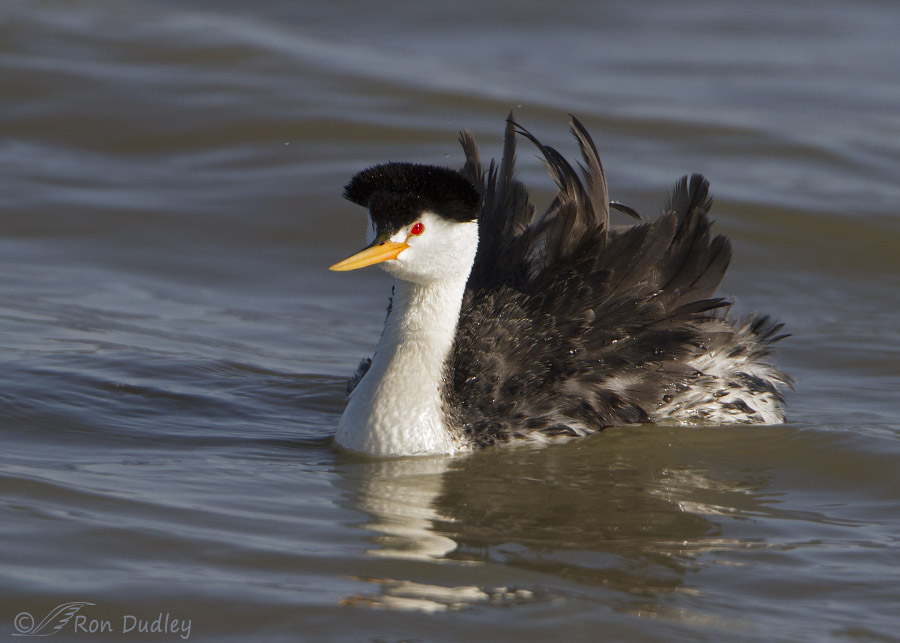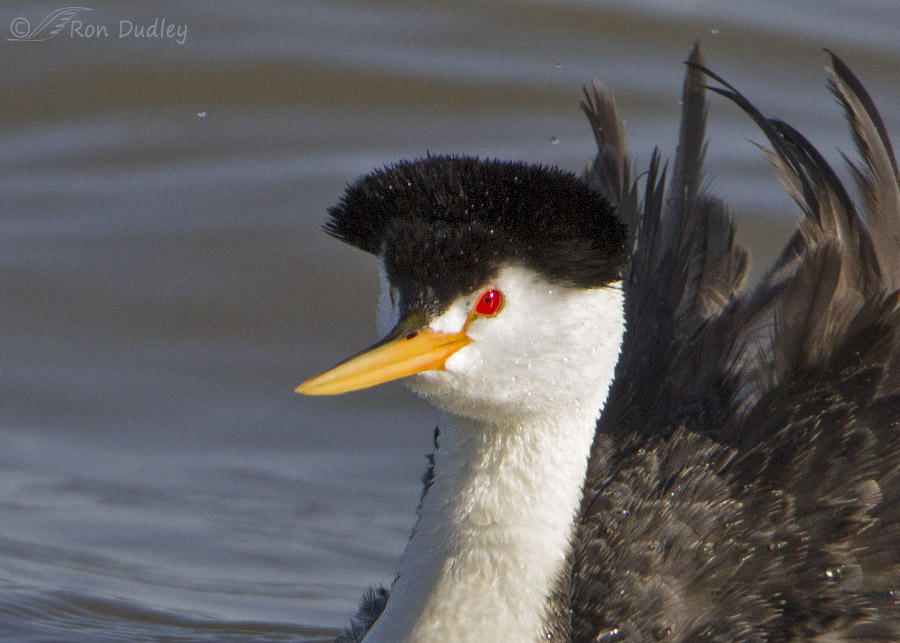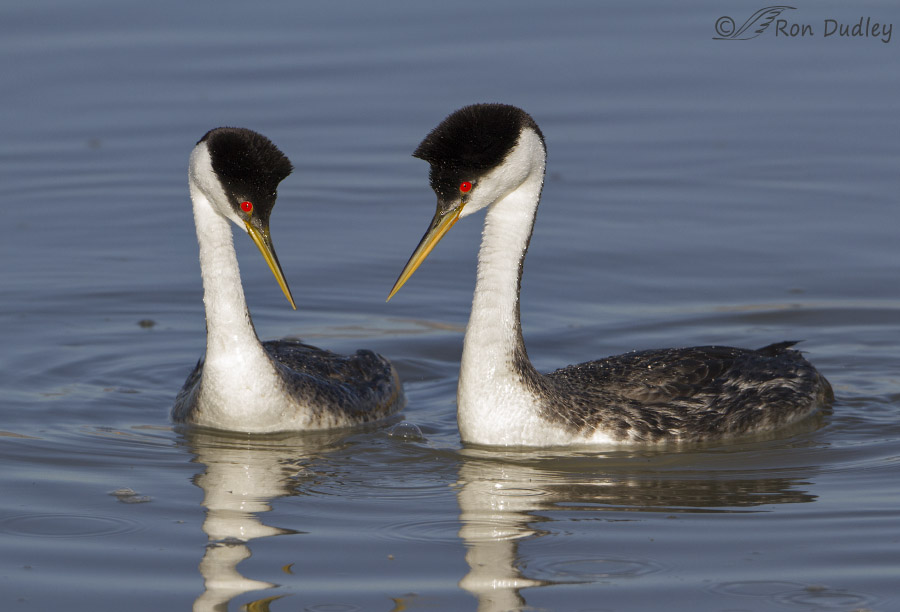Though they can be difficult to see both Clark’s and Western Grebes do have crests.

1/3200, f/7.1, ISO 640, Canon 7D, Canon EF500mm f/4L IS USM +1.4 tc, not baited, set up or called in
Their crests are usually not apparent unless they’re raised and even then can be difficult to notice. Both species (Clark’s and Western Grebes are very closely related and were once thought to be the same species) tend to raise their crests during threat displays and courtship ceremonies. This Clark’s Grebe raised its crest in reaction to another bird that came in too close to its mate. The erect feathers along the back are not part of the display – those feathers were blown erect by the wind (the effect makes me smile…).

When raised during display the crests are triangular in shape, black and spread laterally over the edges of the top of the head. The short feathers at the top of the head are erected and to my eye resemble a flattop haircut that is too big for the owners head – kind of like a Gus Grissom, Roger Maris or H.R. Haldeman haircut on steroids (younger folks may have to look up some of those names or remain clueless…). Haldeman was actually known as “The Brush” (and other less flattering names) during his days in the White House.

1/2000, f/6.3, ISO 500, Canon 7D, Canon EF500mm f/4L IS USM +1.4 tc, not baited, set up or called in
Both sexes have and use their crests. This is a pair of displaying Western Grebes (notice that unlike Clark’s Grebes the black comes down past the eye in Western Grebes) in courtship and both of them have erected their crests. The larger male is on the right.
Both species can be extremely vocal while displaying and just looking at these photos makes me hear their calls in my head. I look forward to spending more time with them this spring and summer.
Ron
Crest triangular, black, raised and spread laterally in display.
Threats, in increasing degrees of intensity: bird may face another, crest spread forward, head held low and give Threat call


Ron. Doesn’t every baseball fan know Roger Maris? Say it isn’t so!
This past Fri., my birding group got to see these birds, both species, starting to run accross the water. This is prefaced by the pair mimicing each others’ behavior: neck twists, turns and bobs; diving and returning with plant material from the bottom; and then presenting this black stringy plant matter to each other…”oh boy, he’ll help me make a great nest!”. Then, every now and then, they’ll rise out of the water and run, in unison. I never get tired of watching them.
Whether the eye is within the black area or within the white isn’t always difinitive. In non- breeding season it’s not so clear cut and we should use other field marks as well: the bill color of Clark’s is an orange yellow, and Western Grebes’ have greenish yellow bills. In decent light, you can see this difference for a good distance.
And, Clark’s Grebes have a one syllable call note, just like Clark’s is one syllable. Western is two syllables, therefore…
This is the Grebe news from Lake Hennessey, east of Napa and St. Helena, Ca.
SUE
Thanks for the info, Sue. Neat, they’re dancing (rushing) already!
First time I saw these birds at Elizabeth Lake, I wondered what hair Salon they went to…They are beautiful birds though. Their eyes are very striking. Beautiful pics as always Ron. Welcome back Patty!!
Thank you, Jean. And yes, it’s nice to have Patty back, isn’t it?
Love the crest. A number of our native birds are also crested – and theirs are raised in curiosity as well as alarm, courtship or threat (which means they are raised often) and tend to make them look a little prehistoric. Much more like the errant feathers spoiling your Grebe’s do.
You’re in crested bird heaven in Australia, EC. We don’t have that many of them, especially those that are dramatically crested.
Flattops were always my favorite haircuts. I can remember two very handsome boys who wore their hair that way in junior high and high school… I love that analogy for these birds’ crests. The Clark’s Grebe in the first shot is really putting on a great feather show. A little bit like Liberace – definitely makes me smile.
Yep, Liberace works for me, Susan…
I always learn something from your posts. Thanks so much!
You’re very welcome, Mary. Thank you.
Loved this morning’s lesson. ;D It’s one of my favorite things about your blog, Ron. How you share so much.
Good! I’m glad to hear that, Arwen.
Having Internet problems. Finally opened this on my phone. These are phenomenal shots Ron!
Charlotte
Good luck with your connectivity issues, Charlotte. Thank you.
That third shot -of the displaying pair of Western Grebes—what GRACE in that composition ! And thanks for making the link to the call–it took me right out on the water…….
Thanks, Kris. I’m glad you enjoyed hearing those calls.
One of my sons- in-law has a similar hairdo, short on the sides, long on top. Looks like he got his head caught in a bench vise….doesn’t have red eyes, though, except when he’s very tired….
Patty, I received your comment email while one the way to Antelope Island this morning, read it to Mia and we both had a good laugh over it. Made the trip go faster – thanks!
Patty, I’m so glad you’re back! As usual, your comment gave me a good chuckle.
Excellent! Perfect example of the difference between the two! These pictures should be in every Bird Guide!! You don’t even need arrows to mark the obvious. Many thanks for the lesson.
“Many thanks for the lesson.”
And many thanks for appreciating it, Dick!